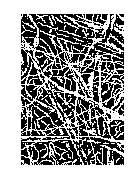Once a normal to the surface at the point of incidence is drawn, the angle of incidence can then be determined. The light ray will then reflect in such a manner that the angle of incidence is equal to the angle of reflection. This predictability concerning the reflection of light is applicable to the reflection of light off of level (horizontal) surfaces, vertical surfaces, angled surfaces, and even curved surfaces. As long as the normal (perpendicular line to the surface) can be drawn at the point of incidence, the angle of incidence can be measured and the direction of the reflected ray can be determined. A series of incident rays and their corresponding reflected rays are depicted in the diagram below. Each ray strikes a surface with a different orientation; yet each ray reflects in accordance with the law of reflection.
 |
(regardless of the orientation of the surface) |
 In physics class, the behavior of light is often studied by observing its reflection off of plane (flat) mirrors. Mirrors are typically smooth surfaces, even at the microscopic levels. As such, they offer each individual ray of light the same surface orientation. But quite obviously, mirrors are not the only types of objects which light reflects off of. Most objects which reflect light are not smooth at the microscopic level. Your clothing, the walls of most rooms, most flooring, skin, and even paper are all rough when viewed at the microscopic level. The picture at the right depicts a highly magnified, microscopic view of the surface of a sheet of paper.
In physics class, the behavior of light is often studied by observing its reflection off of plane (flat) mirrors. Mirrors are typically smooth surfaces, even at the microscopic levels. As such, they offer each individual ray of light the same surface orientation. But quite obviously, mirrors are not the only types of objects which light reflects off of. Most objects which reflect light are not smooth at the microscopic level. Your clothing, the walls of most rooms, most flooring, skin, and even paper are all rough when viewed at the microscopic level. The picture at the right depicts a highly magnified, microscopic view of the surface of a sheet of paper.
Reflection off of smooth surfaces such as mirrors or a calm body of water leads to a type of reflection known as specular reflection. Reflection off of rough surfaces such as clothing, paper, and the asphalt roadway leads to a type of reflection known as diffuse reflection. Whether the surface is microscopically rough or smooth has a tremendous impact upon the subsequent reflection of a beam of light. The diagram below depicts two beams of light incident upon a rough and a smooth surface.

A light beam can be thought of as a bundle of individual light rays which are traveling parallel to each other. Each individual light ray of the bundle follows the law of reflection. If the bundle of light rays is incident upon a smooth surface, then the light rays reflect and remain concentrated in a bundle upon leaving the surface. On the other hand, if the surface is microscopically rough, the light rays will reflect and diffuse in many different directions.


 0
0

